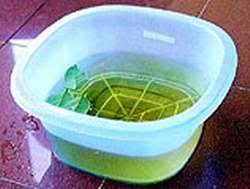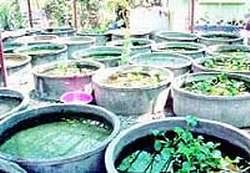Check out this beauty...

Results 171 to 180 of 12139
-
10-19-2008, 12:29 AM #171
-
10-19-2008, 12:30 AM #172
Breeding Bettas The Thai Way

A typical container used for breeding bettas

A large Thai farm boggles the mind with its rows upon rows of betta breeding bowls
The Thai Way
The methods commonly used by large-scale breeders in the Orient, but it can be argued that the best bettas in the world are produced there. Because bettas originate in Asia (and are still found in their wild forms in Thailand, Cambodia, and surrounding areas), not much adjusting has to be made to breed them and raise them to maturity. Many breeders pour the betta fry from the containers in which they were bred into large shallow ponds, and all but forget about them until they are large enough to jar. These are ideal conditions for raising bettas, as it provides them the ideal climate and food source in the way of daphnia, mosquito larvae, and other small water invertebrates. The fry swim and grow and feed as food presents itself.
Most of the breeders we interviewed for this article used a spawning container that would utterly scandalize the purists in America who maintain that bettas can only be successfully spawned in a thickly-planted ten gallon tank filled to a depth of 5 inches. The containers are usually only small bowls, and not even necessarily clear. Anything that can hold water suffices. Atison Phumchoosri of Bangkok uses bowls about 12 inches in diameter, and about 3 1/2 inches deep. 'I put [the breeding pair] into the container with my hands, avoiding water from the bottles, because I want the spawning water to be...without debris from the old bottles.' He drops a few leaves on the surface of the water and covers the bowl with a piece of cardboard, and then lets nature take its course. He reports that spawns usually occurs in just a few hours.
Wasan Sattayapun (also of Bangkok) uses a pottery bowl as a breeding container, asserting that it helps maintain a constant temperature for the fry. He keeps the pair together for up to four days, disturbing them only to check for eggs. If no eggs are found by the four-day mark, he chalks the spawn up as a loss and removes both fish into separate containers.
In this way, the pair is virtually left alone to get the job done without distractions, and it obviously works very well. A breeder will check their progress periodically, and as soon as it is evident a spawn has occurred (usually through spotting the eggs in the nest), the female is removed and the male left to tend the nest. He's allowed to fulfill his obligations until the fry are free-swimming, then he is removed by hand and the fry are fed immediately.
The breeding pair is chosen for their health and vitality, and bettas who are in questionable health are rejected. One of the first things Asian breeders look for in selecting their pair is a bubblenest in the jar of the male, and bright colors in the female. They are fed very well prior to spawning, with rich, high-quality foods, so that they are in optimum health and able to withstand the rigors of courtship, as well as the accompanying period of fasting.
The first food of the fry varies from person to person, but most of them shared a common thread - the vast majority use hard-boiled egg yolk as a staple, from as early as the first day of feeding. A tiny amount is either mashed into water and fed a few drops at a time, or crumbled directly into the tank twice a day. Fry grow very quickly on this protein-rich diet, and even the smallest fry can swallow the tiny particles of egg yolk that are dissolving in the water.
Breeders also report using newly-hatching artemia (baby brine shrimp), infusoria, and rotifers. Once the fry are poured into outdoor ponds to finish growing, some breeders leave off feeding the fry altogether, forcing survival of the fittest, as the strongest fry hunt and the weakest eventually die off.
It must be recognized that, in the areas in which these breeders operate, external factors such as temperature and water quality are rarely considerations. American breeders can (and do!) most certainly raise their fry in outdoor ponds in a way comparable to successful Asian breeders, but due to our colders climes it can usually not be done year-round. Differences in temperment and intensity of color have been noticed in bettas raised outdoors and those raised in aquariums.Last edited by The Good$!!!; 10-19-2008 at 12:36 AM.
-
10-19-2008, 12:40 AM #173
Power Growing Your Fry
By: BettySplendens
Submitted: 8/25/2006
"How do you get your fry to grow so quickly?"
Most experienced breeders are inevitably asked this question, so for this new feature of Bettysplendens.com I'd like to address how to get the fastest growth from your betta fry.
We've all been there at some point. We've read the Aquabid listings or seen bettas on the websites of some high profile breeders claiming that their fully-developed beauties are only 2 or 3 months old, and then looked with exasperation at our own 4 month old tadpoles and wondered what we were doing wrong. The advantages to growing out your bettas quickly is, of course, that you can achieve your breeding goals much faster by being able to perform another filial spawning every 3-4 months than you would by doing it every 7-8 months. Since most of us were attracted to breeding bettas, in particular, because of the almost limitless color/pattern combinations possible with them, moving on to subsequent generations as quickly as possible is in our best interests.
However, you might be among those breeders for whom raising bettas is such a relaxing pastime that you do not mind bringing them along more slowly. In that case, the following may be useful for you if you are interested in showing or selling your fish, and want to get as much growth out of them as possible in a limited amount of time.
Water
This is the one I feel is the most paramount in importance - water quality. Most new breeders do not change the water nearly as often as they should to maximize fry growth. A common reason for this is that many conscientious breeders only feel it is necessary to change the water once or twice a week, enough to maintain healthy ammonia and nitrate/nitrite levels in the growout tank. While this is commendable and goes a long way towards making sure your betta fry remain healthy, twice a week water changes are not sufficient for coaxing the best growth out of your fry.
The explanations for this are far from simple. Scientific studies have proven that most fish, including bettas, excrete a hormone that acts as an inhibitor to growth. In the betta community it has widely been said that this growth hormone stifles the potential of smaller fish in the spawn, giving the advantage to the larger, healthier fry. While this goes a long way to explaining the sometimes dramatic size differences between fry from the same spawn, it is my personal belief based on what I have read that this hormone actually works to limit the growth of the fish so that it does not outgrow its environment. In nature this would be a handy tool, ensuring that there is enough space and resources for all. In the spawn tank, it's just inconvenient. A couple of hundred young fish in a ten gallon tank will soon produce enough hormone to severely limit growth unless the water is changed, and changed often. I change the water in my growout tanks at least 50% every single day. Other successful breeders have reported changing as much as 80-100% per day, with excellent results.
Water changes should begin by about 2 weeks old. If you have started with a half-full tank for the spawn, then by two weeks old you can start adding water, a gallon at a time, every day until the tank is full. This should take 4-7 days, and after that time the fry are usually large enough to make siphoning easier. Simply remove the detritus from the bottom of the tank with a very small airline tubing siphon (I attach a long piece of tubing to a straw so that I can maneuver better) and carefully vacuum the bottom of the tank. When it is clean enough, you can remove the remaining 50% of the water from the top with a clear cup so the job will go a bit faster, and you can see if you've accidentally scooped up any fry. When half of the water has been removed, simply refill the tank with clean, aged/treated water. I wouldn't recommend more than a 50-70% water change per day. While the fish will grow faster removing ALL hormone from the water, I've found that full water changes at this tender age can stress the fry.
Once the fry have been individually jarred, you can continue to expedite growth by giving them 100% water changes every day.
Feeding
Although I always recommend feeding the best food you can to your bettas, I've found that food itself is secondary to water quality. I have raised bettas to show size in 4 months on nothing but pellets and massive water changes. Live and frozen foods aren't critical for fast growth, but they DO improve the health and overall condition of your fish, which contributes to better size - so use them when you can.
An interesting method of power growing betta fry was told by fellow IBC breeder Rob Panerio, who says he can get a young betta to show size in 8-12 weeks using this technique. He combines massive water changes with gut-stuffing the fry with large quantities of high-protein live food. The choice of food corresponds with the current size of the fish; he offers the largest food that a fry can successfully fit into its mouth. They are fed several times a day, as much as they can handle. One might consider this method extreme, since he reports several losses of fry from overfeeding. However, it obviously produces results! As mentioned, he also performs large volume water changes in his fry tanks, a powerful one-two punch that produces large, showy, full sized bettas in a fraction of the time.
I realize that massive daily water changes can take a lot of time, especially when you have more than one growout tank to change. This can be difficult to accomplish, especially as most of us also have to juggle work, families and other non fish related activities. However, if you are having trouble growing your fish, I simply ask that you try it - just once! - just to see what happens. I am confident you will be pleased with the results. In addition to encouraging better growth, frequent water changes and good food also produce better looking specimens once they reach maturity. So roll up your sleeves and go play in the water! I think you'll discover it is worth it.Last edited by The Good$!!!; 10-19-2008 at 12:43 AM.
-
10-19-2008, 12:58 PM #174Senior Member

- Join Date
- Jan 2006
- Posts
- 659
naa nako betta!!
thanks roy!!
gamit kaau mga tips dinhi... keep it up!
-
10-19-2008, 07:35 PM #175
-
10-19-2008, 09:51 PM #176Senior Member

- Join Date
- Jan 2006
- Posts
- 659
yes roy.... thanks!
ask lang unya ko sa mga masters diri...
lingaw kaau ko
-
10-20-2008, 04:25 PM #177
-
10-20-2008, 04:25 PM #178
ANNOUNCEMENT:
ABA Cebu members are encouraged to breed their own quality Bettas since we are going to send entries to the 2nd Philippine Betta Showdown!
We will discuss on this on our meeting this week. Schedule is yet to be finalized...
Thanks!^^

-
10-20-2008, 04:33 PM #179
big time ai...bei sakto kau dagko nato mga fries didto ing jan...he.he...>>>>>>>apil to mu dragon,,,nendot au to bei...UUU
-
10-20-2008, 04:35 PM #180
Advertisement
Similar Threads |
|





 Reply With Quote
Reply With Quote


